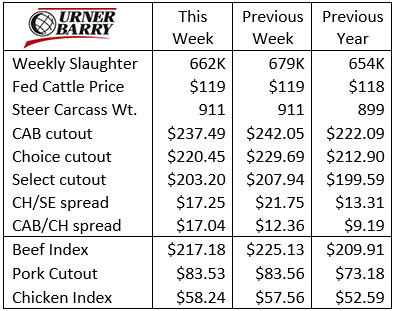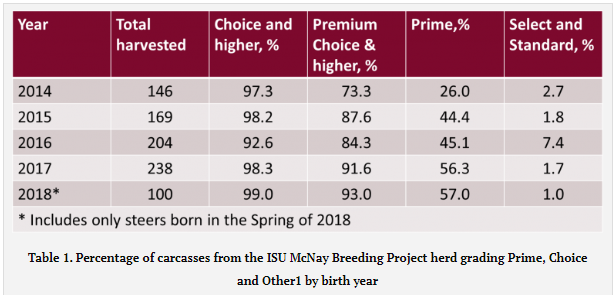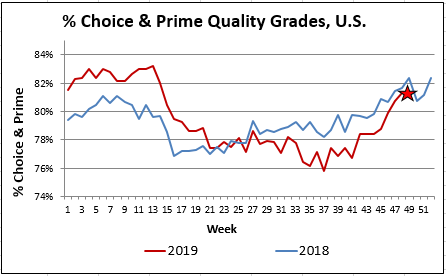
Carcass and maternal traits go hand in glove
MARKET UPDATE
Cash fed cattle prices remained firmer last week with instances of $120/cwt. live trade in Iowa, while eastern Nebraska saw the top end of $190/cwt. dressed, resulting in a weekly live average of $119/cwt.
Two weeks ago the federally inspected 679K head total harvest was the largest since 2011. Another big week last week at 662K head allowed packers to both continue to deliver on large pre-holiday order needs and build inventory ahead of two holiday-shortened harvest weeks coming up.
Packer margins have narrowed rapidly with cattle prices creeping upward and the recent turnaround in boxed beef values. Packers are estimated to be working with profits just above $100/head, a level that will easily stimulate processing volume near term.

Carcass cutout prices last week were reduced quite handily with the Choice carcass values hit the hardest, down $9.24/cwt. in the week to week trend. The CAB cutout was down just $4.56/cwt. on smaller supplies.
Carcass marbling trends across the fed cattle packing sector have picked up lately in a promising pattern with the Choice grade share returning to near year-ago levels. If the trend holds this should right the ship for CAB end-users. More Choice-grading carcasses will spill over to the Premium Choice marbling requirement for the CAB brand, generating more supply and narrowing the price margin between CAB and commodity Choice product.
A brief review across the carcass subprimal cuts this week shows the seasonal turnaround that happens annually in mid-December. Ribeye and tenderloin demand at the wholesale level has dropped off after both of those cuts reached the top of their historical price ranges in the past number of weeks. Protein buyers looking for value in the middle meats should currently be targeting buys for strip loins, short loins and sirloins with an eye toward the spring run-up on those items.
End meats and thin meats generally reflected the lower overall cutout values last week. Chuck rolls have come off of their recent abnormally high prices yet prices still remain significantly higher than anticipated for this time of year.
Carcass and maternal traits go hand in glove
Single-trait selection in beef cattle breeding is fraught with risk regardless of the focus. Some cattlemen have adopted the idea that there are strictly “maternal” and “terminal” lines of cattle within the Angus breed, resulting in sire selection decisions by some to purposefully forego selection toward carcass traits for fear of “ruining the cow herd”.
Fortunately, cattlemen seeking multi-trait excellence need not choose between the ideal cow and exceptional carcass merit.
Researchers at Iowa State University recently detailed in a white paper the results of more than two decades of selection for marbling in the university’s 400-cow Angus research herd. The institution’s initial purpose was to develop two cow herds with one herd selected primarily for marbling and another for retail product yield. A third goal was to further prove advances in genetic selection made using ultrasound technology.
The retail product line of cattle was discontinued after 6 years but the marbling-focused herd, established in 1997, continues in production today. Results of this arduous breeding project reveal important outcomes for all cow-calf producers.

Methods used by the ISU researchers are too lengthy to detail here. However, the background behind the breeding project is that replacement heifers were retained based on selection toward marbling as the primary focus with a degree of attention toward structural soundness, acceptable growth, disposition and the absence of pinkeye. Bulls were retained using essentially the same criterion.
Correlations were then drawn between marbling and maternal traits to determine if the relatively singular focus on marbling had undesirable impacts on the functional cow traits. Traits defining maternal function included expected progeny differences (EPDs) for calving ease maternal (CEM), heifer pregnancy (HP), MILK and scrotal circumference (SC), with the latter having a known impact on age at puberty.
The cowman’s take-home conclusion from this research can be summarized by stating that after 20+ years of selection for marbling the ISU Angus research herd showed no significant detrimental impacts on maternal traits. Correlations between marbling were either weak or non-existent between marbling and the important measurable maternal traits. The summary conclusion statement lists the following:
- Small, positive relationship between milk and marbling EPDs in the herd
- A significant positive relationship between marbling and heifer pregnancy EPDs
- Positive correlations between marbling EPDs and EPDs for scrotal circumference, heifer pregnancy and maternal calving ease
- Marbling EPDs of the cows had a weak negative relationship to total number of calves and calving interval
- Relationships between ultrasound intramuscular fat (marbling) phenotypes of the progeny were not related to reproductive EPDs (CED, CEM, HP, SC, and MILK)
- A positive correlation between marbling and scrotal circumference
Carcass quality grades on the mend
The carcass quality grade trend has been a two-sided story this year with new highs in Choice and Prime grading through the first half of the year. The second half of the year brought about the opposite trend with Choice dipping as low as 2.6 percentage points under a year ago at the widest gap in October. On the other hand, the Prime proportion over the past 6 months has remained much closer to 2018 levels.
The lower grading since June has been a boon to cattle feeders selling high-quality cattle on a carcass merit basis with CAB carcasses bringing more than $100/head premiums, at times, over the weighed market average.

As we move into late December, quality grades are righting themselves with Choice aligning more closely with a year ago. In turn, the Choice/Select spread has narrowed to $9.34/cwt. this Tuesday, according to USDA. The smaller premium has also been predicated by the end of the holiday run-up in ribeye and tenderloin demand.
Certified Angus Beef ® brand product volume has been lower over the past two months as certified carcasses are also fewer on the lower marbling trend and often fewer harvested head since the Tyson-Finney County fire. Our end-user partners have done an excellent job coming into the holiday season with pre-booking ribeyes at lower prices well ahead of the buying frenzy. This allowed many to offer front page features at still attractive prices to consumers.
Even so, the CAB/Choice boxed beef price spread at wholesale was $17.04/cwt. last week. While the production sector has benefited from wider quality spreads, end-users will be incentivized when the spreads narrow. That is very likely to be upon us as we turn to the new year and marbling trends turn higher.
DON’T MISS THE LATEST HEADLINES!
Spring Cove Ranch earns CAB award
Demanding high quality
Good things happen when marbling leads to selection criteria
Trust insurance
Read More CAB Insider
Credit End Meats With CAB Value-Add
We focused on fourth-quarter middle meat demand as a beef price driver in the last edition of the Insider. This is certainly the case in the current data as rib and tenderloins are pricing near their annual highs. However, a look at annual price trends across the beef carcass shows increasing contributions to CAB premiums from both ends of the carcass.
Middle Meats and Supply Driving Fourth Quarter Spreads
At the retail level, November brings a brief shift in focus, away from beef to turkey and ham, for Thanksgiving meals. Turkeys are the classic “loss leader” item in grocery stores during November as retailers practically give them away to lure a volume of shoppers to spend on the high-margin center of the store goods.
CAB Brand Sales Third Best in 45-Year History
In this CAB Insider,shifting market dynamics have already marked trend changes in the 2023 cattle and beef markets. These shifts are most succinctly summarized through two factors, fewer cattle and higher prices, that will further entrench themselves in near term trends.
